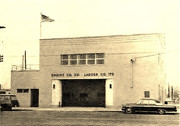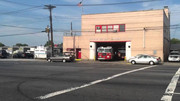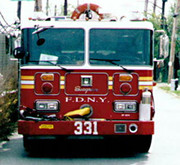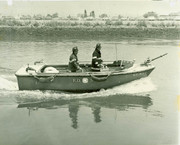Captain Vinny Fowler Ladder 173
"Friday, June 4, 1999. Just 1 day shy of the 1st anniversary of the death of Lieutenant James Blackmore (77-55-2044 6/5/98) the purple & black bunting again dons a firehouse.
99-22-8943 - Thursday June 3, 1999
The South Ozone Park section of Queens is a quiet tree-lined community with rows of detached wood frame houses. The resident of 150-28 127 Street had just returned home from picking up his wife from work. Upon entering the house he discovered that his lights were out and he went to investigate.
In the basement, the circuit breaker panel had overheated and started a fire in the walls. At 1855 hours the alarm was transmitted with ladder 173 first due. Captain Vincent Fowler entered the basement to find the seat of the fire. Followed closely by probationary Fire Fighter Paul Torns, they clambered down a narrow flight of stairs and encountered Colliers Mansion type conditions.
A few minutes after water started the alarm went off in Paul Torns' mask. Under optimum conditions he had 6 minutes of air left. Captain Fowler ordered everyone out of the basement. The water was having no effect and the ceiling was beginning to give way. In the confusion Fowler lost track of Torns. He called out and started searching for him just as his bottle emptied.
Torns found him and gave Fowler a few shots of air from what remained in his tank. In the blinding smoke and confusion both men were unsure of the way out of the basement. With his last breath, Fowler yelled a Mayday into his radio and lost consciousness. Torns tried in vain to drag Fowler out of the basement but debris impeded his progress.
Help quickly arrived but it still took about 15 minutes to get out of the building. Captain Fowler was not breathing. He was brought to Jamaica Hospital where doctors had to restart his heart multiple times.
Amongst the family members that were keeping a vigil at the hospital was his father, retired Battalion Chief Vincent Fowler, brother Fire Fighters John & Andy Fowler, his wife, & 3 daughters.
At 1235 hours of June 4, Captain Fowler lost his last fight. Signal 5-5-5-5 rang out for the 771st time. In keeping with the highest tradition of the Department, Captain Fowler sacrificed his life for that of his 'Proby.'"
- from FDNewYork.com website http://www.fdnewyork.com/
NEW YORK DAILY NEWS - HERO FIRE CAPTAIN DIES WAS TRYING TO SAVE MEN IN BASEMENT WHEN CEILING FELL
Saturday, June 5, 1999, 12:00 AM
BY Leslie Casimir, Martin Mbugua, Don Singleton, Robert Gearty
'It was a hot, smoky fire in the basement of the small Queens ranch home, and when Capt. Vincent Fowler sensed that the first floor was about to collapse, he ran into the thick of it to get his firefighters out. He saved them, but the heroic deed was his last. At 9:35 yesterday morning, 14 hours after he was carried, motionless, from the smoky chaos of the South Ozone Park home, Fowler died in Jamaica Hospital. He was 46. Both of his families were at his side. First there was the family that includes his wife and three grown daughters, his three brothers two of them New York City firefighters his mother and his father, a retired battalion chief. And solemnly standing around the third floor of the hospital was the larger family, the firefighters with whom he had served over his 21-year career, including some of those he gave his life to save. It hadn't looked like a particularly dangerous blaze when Fowler's Ladder Co. 173 pulled up in front of the red brick house at Old South Road and 127th St. minutes after the alarm came in at 6:55 p.m. But the blaze was especially stubborn. A second alarm brought more than 32 units with 121 firefighters. Before the fire was brought under control 11/2 hours later, there were 17 injuries.
And the one death followed the next day. Lt. James Earle was in serious condition at New York Weill Cornell Hospital Center. "What we thought was a routine fire turned into a nightmare," Firefighter Terry Horn of Engine 331 said yesterday as he stood outside the firehouse his company shares with Ladder 173 on Cross Bay Blvd. in Howard Beach. "It still hasn't hit me.
" A grim Mayor Giuliani and Fire Commissioner Thomas Von Essen were at the hospital. Giuliani said, "Capt. Vincent Fowler died because he put his life at risk to try to save the lives of other people. He died a hero.
" In the basement of the South Ozone Park home, events unfolded quickly. Fowler was a "very experienced guy," Von Essen said. "I think [he] knew what was going to happen, started to get everybody out.
" The basement ceiling farthest from the stairs collapsed, firefighters said. "He either went
into cardiac arrest . . . or ran out of air [in his breathing apparatus] and went into cardiac arrest," the commissioner said. Von Essen said pulling the strapping 6-foot-2 captain from the basement was unusually difficult. "He was a very big man," Von Essen said. "He was soaking wet. They had a very tough time dragging him out . . . because a lot of debris had started to come down on him. [It was] a very narrow part of the basement, very narrow stairway with a very difficult turn. "It took them quite a while to get him up those stairs, and all that time he was not breathing. So it was a long time without any oxygen to his brain, and that's what killed him.
" Fire officials said the blaze was electrical in origin. "There appeared to be questionable wiring throughout the house," one official said. Fowler joined the department in 1978 and had received three commendations. He leaves his wife, Ramona, and three daughters, Dina, 21, Amy, 18 and Stephanie, 15. Outside the Fowlers' home on Giller Ave. in Holbrook, L. I., neighbors mourned. "Oh, God, I can't believe it," said Donna Hayden, 48. "He always had you laughing . . . never serious. He was that kind of a guy.
" Graphic: RECENT FALLEN HEROES Fighting fires is a dangerous job that has claimed the lives of more than 750 of the New York's Bravest in the FDNY's 134-year history. Here are some of the most recent fatalities: Dec. 18, 1998: Lt. Joseph Cavalieri, 42, and Firefighters James Bohan, 25, and Christopher Bopp, 27, are killed by a fireball while battling a blaze at a senior citizens apartment building in Brooklyn. June 5, 1998: Lt. James Blackmore, 48, is killed while searching for a woman reported to be trapped inside a burning three-story Brooklyn building. The woman had already escaped. Capt. Scott LaPiedra, 40, injured while battling the blaze, dies 29 days later. April 29, 1998: Firefighter Ray Nakovics, 49, dies after suffering a heart attack while battling a blaze in Hell's Kitchen. Feb. 5, 1996: Firefighter Louis Valentino, 37, dies after a roof collapses during a Brooklyn blaze. Jan. 6, 1996: Firefighter James Williams, 38, dies after opening a door while battling a blaze in Far Rockaway, Queens, and being hit by flames. Jan. 1, 1996: Lt. John Clancy, 35, is killed when a landing collapses in a Jamaica, Queens, building. Oct. 8, 1995: Firefighter Peter McLaughlin, 31, is consumed by a backdraft while searching for survivors of a Long Island City, Queens, fire. March 7, 1995: Lt. Raymond Schiebel, 49, suffers a fatal heart attack while battling a blaze in Brooklyn. Dec. 27, 1994: Probationary Firefighter Thomas Wylie, 30, is killed in a Chinatown blaze. Aug. 7, 1994: Capt. Wayne Smith, 37, is badly burned in a Jackson Heights, Queens, fire and dies 56 days later. June 5, 1994: Lt. George Lener, 41, dies in an arson fire in lower Manhattan. March 28, 1994: A fireball in a SoHo building takes the lives of Capt. John Drennan, 49, and Firefighters James Young, 31, and Christopher Siedenburg, 25. Notes: The was the Front Page story in the National edition







































